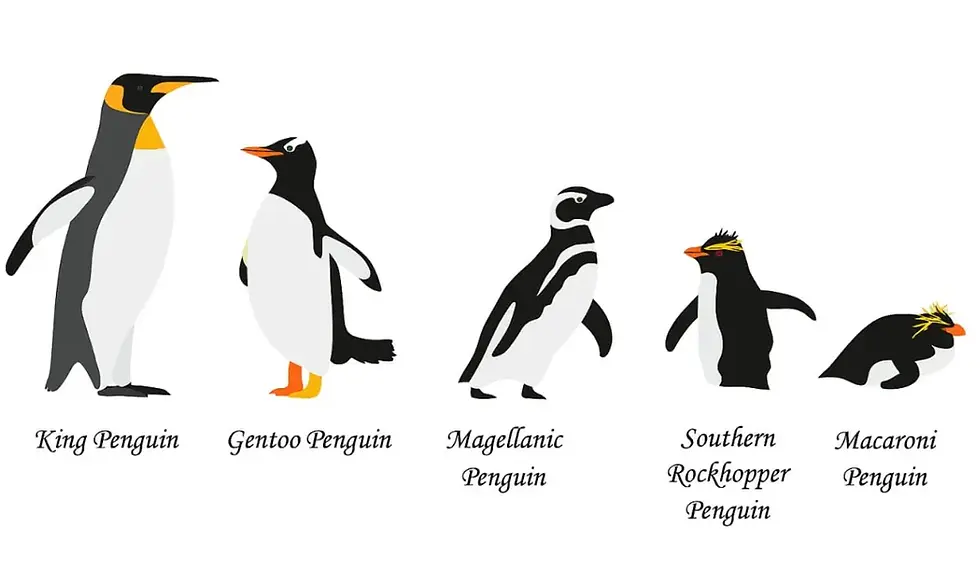Types of Penguins in the Falkland Islands: A Guide for Wildlife Lovers
- Jimmy Anderson
- Aug 4
- 4 min read
Quick Facts About Penguins in the Falkland Islands
Feature | Details |
🐦 Number of Penguin Species | 5 breeding species (Gentoo, King, Rockhopper, Magellanic, Macaroni) |
🗓️ Best Time to Visit | October to March |
📍 Top Viewing Location | Volunteer Point |
🤯 Unique Fact | 1000+ penguins inhabit the islands |
⭐ Famous Species | Gentoo, King, Rockhopper, Magellanic, Macaroni |
🚙 Accessibility | Via guided 4x4 or walking tours from Stanley |
Types of Penguins in the Falkland Islands

Why the Falklands Are a Penguin Paradise
The Falkland Islands are home to one of the world’s most accessible and diverse penguin populations. Whether you're a birdwatcher, photographer, or nature lover, these islands offer the rare chance to see multiple penguin species in one trip.
With over a thousand penguins spread across pristine beaches, rugged cliffs, and protected rookeries, it's no wonder the islands are a must-visit for wildlife enthusiasts.
The 5 Types of Penguins in the Falkland Islands
1. King Penguins – The Majestic Giants
Second-largest penguin species after Emperor penguins
Found year-round at Volunteer Point, where over 300 breeding pairs nest
Elegant, tall, and photogenic with orange neck patches
2. Gentoo Penguins – The Most Common
Easily recognizable by their bright orange beaks and white head stripes
Over 400 breeding pairs in the Falklands
Frequently seen at Bertha’s Beach and Yorke Bay Penguin Colony
3. Rockhopper Penguins – The Entertainers
Known for their red eyes and spiky yellow eyebrows
Nest along rocky cliffs—best spotted in the Jason Islands and Kelp Point
Their energetic hopping behavior delights visitors
4. Magellanic Penguins – The Tunnel Dwellers
Burrow-nesting species with a love for coastal scrubland
Common along beaches, especially Gypsy Cove and Surf Bay
Their black-and-white bands make them easy to identify
5. Macaroni Penguins – Rare Visitors
Bright yellow crests similar to Rockhoppers but more elusive
A small number breed in isolated western islands
Best seen with specialized expedition tours
Map: Types of Penguins on Falkland Islands
A visual map showing where each species is predominantly found enhances planning. Our expert guides will help you reach these remote spots safely and comfortably.
Note: A digital map is included in our tour brochure or available on request.
Best Time to See Penguins in Falkland Islands
October to December – Nest-building and mating season
January to February – Best for chick viewing and photography
March – Penguins begin molting, still great for sightings
Tip: Most tours run from October to March for maximum sightings.
Top Locations to Spot Penguins
Volunteer Point – Best for King penguins (accessible via 4x4 from Stanley)
Bertha’s Beach – Known for large Gentoo colony and scenic walks
Gypsy Cove – Ideal for spotting Magellanic penguins near Stanley
Yorke Bay Penguin Colony – A peaceful spot, included in our tours
Kelp Point (Whale Point) – Remote location for Rockhopper sightings
Falkland Islands Penguins and Landmines
After nearly four decades, beaches like Yorke Bay in the Falkland Islands were officially declared landmine-free in 2020. Over 13,000 mines left by Argentine forces during the 1982 conflict had kept these scenic areas off-limits.
UK-funded efforts, supported by Zimbabwean demining teams and firms like SafeLane Global, cleared the mines. The clearance not only reopened beaches to locals but also protected thriving penguin colonies that had inhabited the untouched areas.
Source: Daily Mail
Falkland Islands Penguin Population
The Falklands host 1000+ penguins, with species populations continuing to recover thanks to strict conservation.
🤔 Funny But True: Falkland Islands Penguins Falling Over?
A long-standing myth suggests penguins fall over watching planes—this has been debunked. Penguins are curious but rarely topple. It’s still a humorous and beloved local tale shared on tours!
Related Guide
Explore the Yorke Bay Penguin Colony for a quiet, scenic penguin-viewing experience just minutes from Stanley.
History of Penguins in the Falklands
Penguins have thrived in the Falkland Islands for thousands of years, long before humans arrived. Historically, early sealers and whalers recorded vast penguin populations, and by the 20th century, the Falklands became known as a seabird haven.
Conservation efforts began in earnest in the 1980s, especially after the war, which ironically kept some penguin habitats safe due to landmines. Today, penguins remain central to the islands' eco-tourism and conservation identity.
Areas like Volunteer Point are now globally recognized for sustainable penguin tourism. Our agency proudly supports eco-friendly tours that respect wildlife and preserve this history for generations.
Planning Your Penguin Tour: Tips for Visitors
✅ Bring layers—weather changes quickly
✅ Use zoom lenses for ethical photography
✅ Respect penguin space (minimum 6 feet distance)
✅ Book early during high season (December–February)
✅ Travel with a licensed guide for access to remote rookeries
FAQs: Types of Penguins in the Falklands
Q1: How many types of penguins are in the Falkland Islands?
A: Five species breed in the islands: King, Rockhopper, Gentoo, Macaroni and Magellanic, penguins.
Q2: When is the best time to see penguins in the Falklands?
A: From October to March, especially January for baby chicks.
Q3: Can you see Emperor penguins in the Falkland Islands?
A: No, Emperor penguins are found in Antarctica. King penguins are the closest relative seen here.
Q4: What’s the easiest penguin colony to access near Stanley?
A: Yorke Bay and Gypsy Cove are within 30 minutes of Stanley and ideal for day trips.





Comments